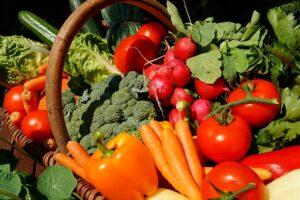Consumers can find a rich selection of vegetables in the period before Easter
Domestic stores await customers with a rich selection of vegetables, and domestically grown spring onions, radishes and lettuce can also be the jewel of the Easter table. According to the overview of the National Chamber of Agriculture and the Hungarian Vegetable and Fruit Interprofessional Organization (FruitVeB), as the season progresses, domestically grown vegetables will replace imports.

(Photo: Pixabay)
Although the selection of vegetables in stores is significant all year round, starting from the early spring period, Hungarian products will replace imports in more and more vegetable varieties. According to the overview of the National Chamber of Agriculture and the Hungarian Vegetable and Fruit Interprofessional Organization, early domestic lettuce usually appears in supermarkets in February and then a rapid increase follows until the end of April.
In terms of demand, the dominance of head lettuce seems to be breaking
Although it is still in high demand, there is growing interest in other types of lettuce, especially iceberg lettuce and torn lettuce. In our country, the area under lettuce cultivation was around 650 hectares in the past 5-6 years, with a harvest of 37-38 thousand tons. However, last year, the area under cultivation decreased significantly, by about 200 hectares to 430 hectares, with a harvest of around 24 thousand tons. The reason for the significant decrease in area is primarily due to the decline in open field cultivation, which has become extremely risky due to unfavorable weather. It is not easy to grow lettuce in Hungary today; due to the extreme heat and drought periods, continuous irrigation is required, which increases the appearance of weeds. The future is expected to be represented by romaine lettuce, which does not wilt for two weeks when stored in the refrigerator. Today, iceberg lettuce is even more widespread, with its large, dense heads being much more durable than lettuce, which can only be stored for a few days, and it can also be easily stored and processed. In addition, its cultivation is simpler, and in terms of work organization and labor costs, it is a great advantage that its picking can be mechanized.
In Hungary, the month-old radish is one of the very first, if not the very first, kitchen garden plants that can be planted in early spring
In case of mild February weather, the month-old radish can be planted and sown in late winter and early spring. In greenhouse cultivation, the month-old radish is the first major source of income for horticulturalists, so they try to plant it as soon as possible so that the planting of the main crop does not slip. Although its share in domestic vegetable production is very low, radish is our second most important cold-tolerant vegetable species after lettuce. In our country, radishes are grown on about 100 hectares, typically under smaller air spaces, unheated or slightly heated foil, or flat foil and veil foil, primarily in Bács-Kiskun and Csongrád-Csanád counties. Domestic month-old radishes are present in the Budapest Wholesale Market and in retail chains all year round. Different varieties of spherical month-old radishes are sold in bunches. However, in recent years, 250-300 gram products containing cleaned tubers, packaged in unit packages, have also appeared on the shelves of supermarkets. Similar to lettuce and month-old radishes, spring onions can now be found in the offer all year round, so like other spring vegetables, the demand is continuous. Spring onions are grown on approximately 130 hectares in Hungary, and the harvested yield has been around 2 thousand tons in recent years. Domestic spring onions are offered year-round at the Budapest Wholesale Market and can be found on the shelves of supermarket chains.
NAK
Related news
The Ministry of Agriculture is helping dairy farmers with a new tender
🎧 Hallgasd a cikket: Lejátszás Szünet Folytatás Leállítás Nyelv: Auto…
Read more >AM: Tax and administrative burdens for farmers to be reduced from January 1
🎧 Hallgasd a cikket: Lejátszás Szünet Folytatás Leállítás Nyelv: Auto…
Read more >The Ministry of Agriculture supports farmers’ awareness with as many tools as possible in 2026
🎧 Hallgasd a cikket: Lejátszás Szünet Folytatás Leállítás Nyelv: Auto…
Read more >Related news
Circular transition more urgent than ever
🎧 Hallgasd a cikket: Lejátszás Szünet Folytatás Leállítás Nyelv: Auto…
Read more >Ads Interactive Media Group will sell the retail media platforms of Auchan Hungary Kft. stores from 2026
🎧 Hallgasd a cikket: Lejátszás Szünet Folytatás Leállítás Nyelv: Auto…
Read more >Foxfilm teaches entrepreneurs how to make videos
🎧 Hallgasd a cikket: Lejátszás Szünet Folytatás Leállítás Nyelv: Auto…
Read more >







